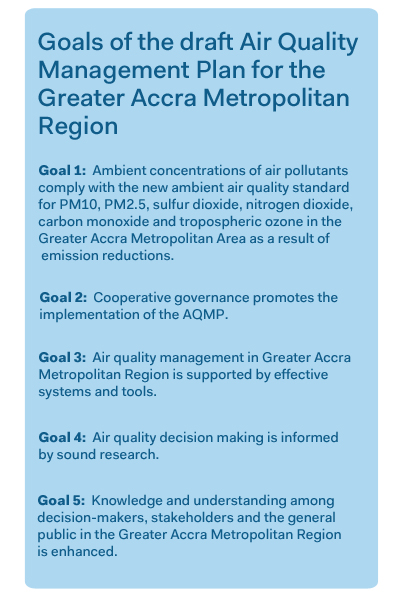An estimated 440 lives could be saved per year from the clutches of respiratory and cardiovascular disease, and five thousand asthma-related medical visits could be avoided in the Greater Accra Region in 2030 and beyond, if a new Air Quality Management Plan is adopted for the region, according to Ghana’s Environmental Protection Agency (Ghana EPA).
The new Air Quality Management Plan, announced today in draft form for public comment, includes proposals for tougher national emissions standards for vehicles and fuels, industry and waste burning, as well as for ambient air quality levels.
Ghana EPA is also working with the World Bank and the United States Environmental Protection Agency (US EPA) to deploy an enhanced air quality monitoring network, including improved data assessment and reporting.
This included the recent deployment of new low-cost sensors in strategic parts of the Accra that are not well covered by the city’s present-day network. These will also be used to measure and monitor waste burning hot spots, which are a particular problem in Accra, site of one of Africa’s largest e-waste facilities.
Apart from the development and proposal of emissions and ambient air quality standards, the Air Quality Management Plan includes new analysis of the contribution different sources make to air pollution, an evaluation of air quality monitoring data, and estimations of the current and projected future health burden of air pollution in the Greater Accra Region, which extends well beyond the Accra Metropolitan Area and includes some 4 million people.
“Under the Megacity Partnership, USEPA has worked alongside the Ghana EPA since 2015, building capacity to analyze the benefits of air pollution reduction policies. These policies form the basis of the Air Quality Management Plan announced today, and when implemented will significantly improve the health of those living and working in Accra,” said Head of Environmental Quality at Ghana EPA, Emmanuel Appoh.

Ghana’s first Air Quality Management Plan focuses Accra and the broader region, for three reasons:
• Accra frequently suffers high concentrations of fine particulate matter pollution. This presents an unacceptable health burden for Accra’s population and are not in line with World Health Organization guidelines for air quality.
• The cost of inaction is high. The health burden of diseases caused by high air pollution levels also have clear economic implications, leading to excessive sick days, and time off of school and work, and presenting a direct social and economic cost in terms of health care treatment.
• Without action now, pollution will become worse. Economic and population growth in the area will lead to skyrocketing emissions, particularly in the vehicle and industrial sectors, which will worsen air quality over time.
The plan’s ultimate goal is to bring particulate matter pollution into “full compliance with national ambient air quality standards by 2022” and to ensure that “the state of compliance is maintained as the region develops economically”.
“Current and previous efforts to monitor and manage air pollution emissions in Greater Accra have been successful, but significant gaps remain in several aspects of the process,” said Appoh.
“The new air quality management plan has been designed to address these gaps,” he said.
One of them is consistent, comprehensive and accurate monitoring of air quality, something EPA Ghana, the World Bank and USEPA intend to tackle by deploying an enhanced air quality monitoring network, consisting of a low-cost sensor network and a set of reference-grade instruments that would operate as a single, integrated system.
If implemented well, the combination of the three could be a game-changer for the city.
“Together, the new plan, standards and monitoring system pack a powerful punch,” said Appoh.
“The standards should encourage the government to plan and take action across different sectors to improve air quality, and to establish and implement nationally determined air quality and emissions standards that take relevant information into account,” he said.
The air quality standards would provide new public health-based benchmarks for the main air pollution indicators that coincide with targets of relevant 2030 Sustainable Development Goals— that is, the ones that aim to cut deaths from pollution and improve public health and wellbeing.
In fact, Ghana EPA estimates that the adoption of the stricter emissions standards for transport and the other sectors covered could save 440 lives a year by 2030.
It is also hoped that the new standards will encourage the public and economic actors to take supportive action to improve air quality.
The draft Air Quality Management Plan is up for public comment, after which it will be finalized.
More information on Ghana’s air quality efforts can be found at Ghana EPA’s website.
Read the press release here: GHANA ENVIRONMENTAL PROTECTION AGENCY IN COLLABORATION WITH US ENVIRONMENTAL PROTECTION AGENCY ON LAUNCH OF AIR QUALITY MANAGEMENT PLAN – AUGUST 2018
Banner photo by Joana Ansong/WHO.